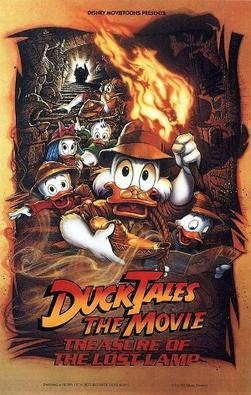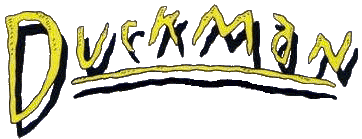02.06
http://www.youtube.com/watch?v=2e5q6ubDlZE
Watching Gummi Bears and DuckTales again, I can’t help but notice that Disney Television Animation’s staff was very competent back in the 80’s. I would figure that Chip ‘N Dale Rescue Rangers, the series that was initially syndicated alongside DuckTales in 1989 and also joined both of these shows with TaleSpin as the first Disney Afternoon lineup, would hold up as well as each of these mentioned series. Although the show’s last batch of episodes aired around the time the block debuted, the series lasted on the block until it’s third season ended in 1993.
It does, but not as much, but I can’t help but admire the series, no matter what.
Around the time DuckTales and Gummi Bears were proving to be big successes for Disney, some of the creative forces at the mouse house were planning for another series to follow DuckTales in the syndication market. Initially, the idea was to have a group of small animals who solved crimes too “small” for the police to handle, similar to their own 1977 film, The Rescuers. The group would consisted of an adventure loving mouse by the name of Kit Colby, a female mechanic mouse named Gadget Hackwrench, a cheese-loving Australian mouse known as Monterey Jack, and a chameleon who fit into the group. Heads Michael Eisner and Jeffrey Katzenberg liked the show idea, but wanted classic Disney characters to be used in the show instead of all originals. Creator Tad Stones suggested bringing back Chip ‘n Dale, former chipmunky pests of Donald and Pluto, which caught the attention of Eisner and Katzenberg. Obviously, two of these characters would stay and the rest, as they say, is history.
While the show did well and still has a solid cult fanbase to this day, Rescue Rangers doesn’t quite hold up as well as DuckTales does. There is plenty of good in the show, but it’s scattered around more than it should be.
One thing that rubs me the wrong way about the show is, of all things, Chip and Dale. To make the two seem more distinctive than just by their noses, Chip, the black nose, wears a fedora and jacket similar to Indiana Jones, while Dale, red nose, wears a Hawaiian shirt to make him reminiscent of Magnum, P.I. Chip is more straightforward and is very determined in his work, while Dale is laid back and plays around more. Maybe it’s just me, but I don’t tend to find them as entertaining as other characters on the show. Gadget, Monterey Jack, and even Monty’s trusted fly friend Zipper get more development than either Chip or Dale do. This makes sense, since the chipmunks were last-minute additions, but there doesn’t seem to be any effort to mature the two above grating slapstick and irritating processed voices.
Gadget and Monty save the show in terms of characteristics. Gadget is as fully realized of a person as the average DuckTales character. She grew into handywork thanks to her late father, who used to be a pro at doing things. She proves her worth to the Rescue Rangers by building things for them, and while a good amount of her projects work, she often gets in the way of her own inventions. She also happens to be the group’s mother figure, and does a good job of keeping the rest of the Rangers in check, as the three boys are big over-the-top personalities who often clash, while Gadget is active but not as headstrong as the boys. Gadget means well but is also quite clumsy, and incredible insecure, which makes her an endearing non-Sue character.
Monterey Jack doesn’t have much to him, but he does tend to have some funny moments. As you can guess by his name, Monty loves him some cheese, and goes on “cheese attacks” whenever he sees some Swiss, cheddar, or gouda He also tells the gang some grand stories about past adventures that he may or may not have actually been involved in. Most of these tend to be entertaining, thanks to the delivery of voice acting legends Peter Cullen and Jim Cummings, both of which played the rat at some points on the show. His strength and intuition proves his weight to the Rangers, while his cute little chum Zipper doesn’t add as much to the show. He doesn’t communicate well with the group, and when Zipper is at the center of the episode, it tends to revolve around how the gang don’t appreciate him. As Zipper doesn’t do much worth remembering in the majority of the show’s run, it’s not hard to understand why he feels neglected.
There are two main recurring villains in the show, with a handful of other antagonists sprinkled around. One of the main baddies, Fat Cat, typically works well. He’s a feline mob boss whose main objectives typically involve stealing items of the expensive kind or attacking dogs. The Rescue Rangers often take him down, which causes his temper to rise. Fat Cat tends to be an engaging villain when he appears, thanks in part to Jim Cummings’ smooth take on the character, which makes him a bit more likable than he should be.
Professor Nimnul, however, isn’t as great. One of the details about the show that makes it different from other Disney Afternoon programs is that although animals are the main characters, humans exist in their world as well, which makes the Rangers seem small time in comparison. Nimnul is a human mad scientist who messes around with the laws of nature, usually with animals as his test subject, for his personal gain. While he’s also voiced by Cummings, Nimnul tends to be more aggravating than entertaining, as his voice is overly high pitched and his actions tend to be needlessly stupid. There are clever episodes involving him, such as “A Fly in the Ointment”, in which Nimnul and Zipper change bodies in a spoof of the then-recently remade horror classic The Fly, but the Professor is never one of the show’s better characters.
All of these characters are introduced in the five-part premier movie, “To the Rescue”, which is probably the series finest moment overall. In it, a friendly detective is accused of stealing a priceless ruby, which causes Chip and Dale to work together to put the person who actually stole it to justice, the culprit of which conveniently is the owner of Fat Cat. Along the way, they meet Monterey Jack and Zipper, who want to help the two, and suggest visiting Geegaw Hackwrench, Monty’s old inventor friend. When they arrive at Geegaw’s old work house, they run into Gadget, his daughter, who informs the four that her father isn’t with them, but she has been following in their footsteps. They follow Fat Cat and his owner to a dog pound, where a group of dogs help the gang in catching up on them. Later on, Nimnul and Fat Cat’s owner attempt to make an earthquake to open a Reserve Building vault, so they can take the gold from it, which the newly formed Rescue Rangers also foil.
A lot goes on in these five episodes, but TMS does a good job with the animation, and the writing is at it’s most clever for the series. Each of the Rangers get their own solid introduction, Monty especially gets a decent character arc as he decides if he can hold his cheese attacks long enough to help the guys, and the villains are also presented well.
Another issue with the show is the animation As mentioned, TMS did fine when they had their hands in the show, which lasted mostly for the first 13 episodes and the pilot, which you could title the Disney Channel run. Other wise, Wang and Cuckoo’s Nest, who took on DuckTales for the rest of it’s run, did the work for Chip ‘N Dale. While DuckTales suffered a bit in terms of animation without TMS, Wang tended to still have fun with DuckTales, especially when Fenton appeared on screen. In Chip ‘N Dale, however, often times it seemed as if working on the show was more like a chore for the animators, as post-TMS episodes tend to look cheap in comparison to other Disney programs from the time.
One episode that especially suffers from lazy work, despite the quality of the script, is “The Case of the Cola Cult”, in which a cult who “feel the fizz” of Koo Koo Cola try to get the Rescue Rangers to join. Gadget, whose new products had proven unsuccessful earlier in the episode, leaves the Rangers and finds safety in the cult. The Rangers go back to save her, but get stopped along the way. While this episode brings a striking point by suggesting that cults give insecure people safety and comfort while also giving it’s members stranger, higher requirements than an average religion would, while also being a good episode for Gadget’s character, it’s animation kills it.
For one, the episode relies on the need of three cola flavors, orange, grape, and cherry, as well as the need for these drinks to be poured on it’s cult members, but orange tends to be the overwhelming favorite, which is what Chip, Dale, and Monty are sprayed with when they reenter the base, or when Gadget becomes accepted into the cult. Since Gadget’s jump suit is purple, why not use grape in favor of orange? You can even notice in some instances when cherry flavor is used that the person being soaked will be turned into orange instead of red. Then there are the cola ninjas, who fight off the Rangers when they enter the base unwelcome. They move embarrassingly choppy, like if someone left their PS2 with Prince of Persia in it over night, and fall even more awkwardly. Ninjas should move smoothly and look cool, which these absolutely fail to do.
This is merely one example of how bad animation can ruin a good show, but even at it’s worse, Chip ‘N Dale looked better than many of the cartoons airing at the time of it’s airing.
And at it’s dumbest, the show was also better written than many of the animated series that were airing at the time, as well as most of what Disney has put out in the past few years. For example, I watched an episode of Phineas & Ferb, Disney’s latest money-making cartoon, not too long ago, and I found it to be disposable garbage, highly derivative of other cartoons you can find on other channel, in terms of writing and animation. While Chip ‘N Dale Rescue Rangers could be considered to look similar to DuckTales or Gummi Bears, mainly in terms of color and fluid character designs, at least these series had a distinctive style of artwork that can be easily traced to Disney, while Phineas & Ferb looks like all the other series currently out there. Even then, Rescue Rangers had it’s own, authentic modern American look which contrasted from DuckTales‘ lavish Duckburg or Gummi Bears’ renaissance revival.
Chip N’ Dale Rescue Rangers was the lesser of the block’s first three series, but had enough strong points to make it it’s own, unique show that was worth sitting through the whole block for to see the other shows.
Two volumes of the show have been put on DVD. While only 14 episodes ramain to be released, Disney has stalled finishing this show’s release as well as Gummi Bears and DuckTales‘ releases. Perhaps if you buy these sets if you haven’t already will give Disney the initative to put the rest of the series out.
Originally posted on Wednesday, June 2, 2010.













